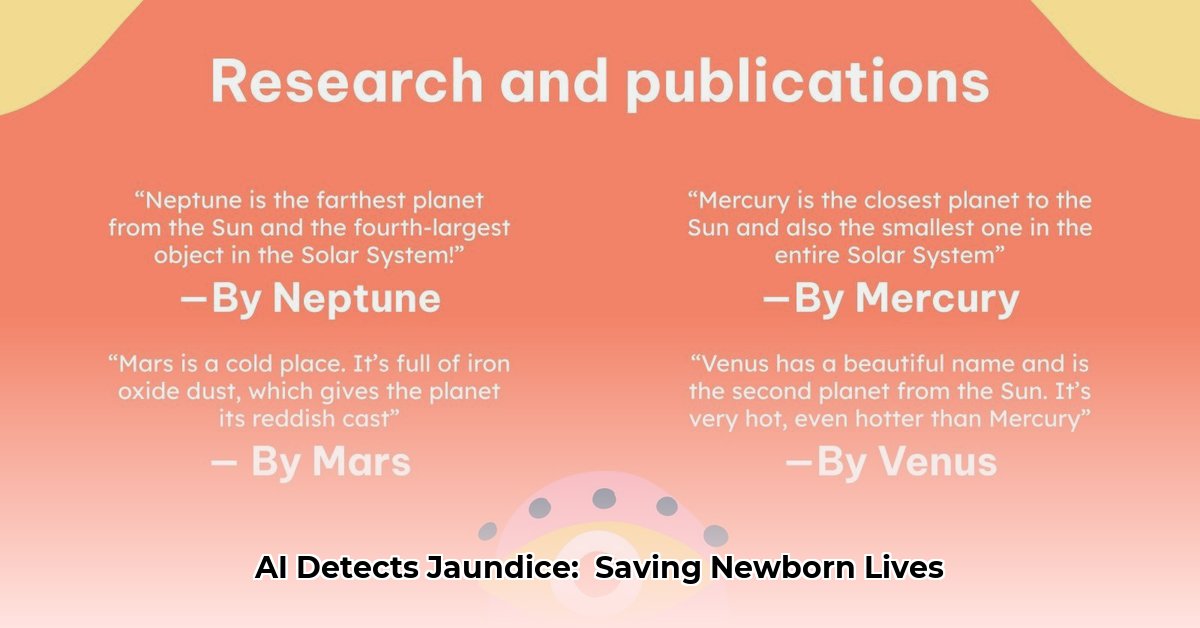Imagine a tiny baby, their skin turning a little yellow. That yellowing, called jaundice, can be serious if not caught early. Traditionally, doctors use needles to check for it, but new technology using artificial intelligence (AI) is changing things. This article explores these exciting new ways to spot jaundice quickly and easily, explaining how they work and what the future holds for keeping babies healthy. We’ll look at simple, painless methods and see how AI is making a real difference in the lives of newborns around the world. For more on non-invasive testing, see this article.
AI’s Role in Revolutionizing Neonatal Jaundice Screening
Imagine a future where checking for jaundice in newborns is as easy as taking a picture with your phone. No more painful heel pricks! That’s the exciting promise of artificial intelligence (AI) in detecting jaundice early, potentially improving bilirubin level analysis. Researchers are developing incredible AI tools that can analyze images and, in some studies, achieve accuracy rates exceeding 90% when compared to traditional methods! This means faster diagnoses and less stress for babies and parents, and ultimately could lower the risk of long-term complications. What are the key areas where AI can make an impact on this common neonatal condition? Furthermore, mobile-based applications utilizing smartphone cameras have demonstrated satisfactory results in field settings, offering a practical alternative for resource-constrained areas.
The Potential of AI for Early Detection of Neonatal Jaundice
Several studies have shown that AI, using techniques like Machine Learning (ML) and Deep Learning (DL) can be incredibly good at spotting jaundice, thereby supporting preventive care. Think of these algorithms as trained detectives, finding subtle changes in skin color and complex patterns that might be missed by the human eye. These AI systems analyze images – photos of a baby’s skin – to quickly estimate bilirubin levels, a key indicator of jaundice. High bilirubin levels can cause serious problems if left untreated, so early detection is very important. The speed and accuracy of AI could be a game-changer, especially for babies needing immediate intervention, and could reduce the need for painful and repeated blood tests. One study reported accuracy rates exceeding 90% using AI analysis of images, demonstrating the ability to enhance diagnostic accuracy.
Understanding Accuracy and Limitations in AI Jaundice Detection
The high accuracy rates reported in some studies are encouraging. However, understand that these results often come from specific situations and testing conditions. Many of the AI models were trained on limited datasets. This means they may not have seen enough examples of babies with different skin tones or photographed under various lighting conditions. If the AI hasn’t “seen” enough different situations, it might misjudge a baby’s bilirubin level. If the AI is trained mainly on pictures of lighter-skinned babies, it might not be as accurate at detecting jaundice in darker-skinned babies. This bias is a significant concern that researchers are actively working to address. Some non-invasive approaches adopt the use of image processing tools to tackle some of the aforementioned limitations.
Navigating the Path to Wider Adoption of AI Jaundice Tools
Getting these AI tools into widespread use is a big undertaking. Before doctors can use any new technology, it needs to be thoroughly tested and approved by regulatory bodies. It’s similar to how new medicines must undergo extensive testing before they can be prescribed. AI algorithms need rigorous testing to prove they’re both safe and reliable under different conditions. Many hurdles need to be cleared before AI-powered jaundice detection becomes standard practice. This process will take time and a multi-pronged approach. What specific challenges need to be resolved to make this technology accessible to all?
Key Challenges and Overcoming Them
Several key challenges must be addressed before AI-based jaundice detection becomes widely used:
- Data Diversity: Huge, diverse datasets of baby photos reflecting different skin tones, lighting, and angles are needed to create AI models that can accurately assess bilirubin levels in all babies.
- Bias Mitigation: Researchers are working to identify and remove any bias in the AI algorithms, ensuring that the tool works fairly for everyone. This careful work is essential to prevent misdiagnoses based on things like skin color.
- Regulatory Approval: Clear and efficient pathways for regulatory approval are essential, allowing new AI tools to be tested and released faster, getting them into the hands of healthcare providers sooner.
- Clinical Validation: Extensive clinical trials are necessary to confirm that these AI systems work reliably in real-world settings, providing concrete evidence of the technology’s effectiveness and safety with a high success rate.
- Addressing Ethical Implications: Evaluating the ethical and practical implications of integrating these technologies in clinical practice, ensuring responsible use.
The Collaborative Effort Needed for Better Newborn Care
The development and implementation of AI-powered jaundice detection require a team effort. Researchers, healthcare providers, government agencies, and technology developers all have a role to play. This collaborative approach is essential to make this life-saving technology available to everyone, leading to improvements in overall healthcare, including reducing hospital readmission in newborns. Maternal education and empowerment are essential for timely jaundice detection, particularly in low- and middle-income countries as it is crucial for effective interventions to address severe neonatal jaundice burden.
Roadmap to the Future: Short and Long-Term Goals
Here’s a look at what different stakeholders need to focus on in the near future and further down the line:
| Stakeholder | Short-Term Goals (0-1 Year) | Long-Term Goals (3-5 Years) |
|---|---|---|
| Researchers/Developers | Create larger, more diverse datasets; rigorously test AI models; actively address algorithm bias. | Secure regulatory approval; work toward seamless integration into existing healthcare systems; explore new imaging technologies and wearable sensors for real-time bilirubin monitoring. |
| Healthcare Providers | Pilot test AI tools; implement updated screening guidelines; train staff on the new technology. | Widespread adoption of AI; enhanced use within electronic health records (EHRs); improved data sharing. |
| Governments/Funding Bodies | Fund ongoing research; incentivize the development of affordable AI tools; streamline approvals. | Establish national screening programs; expand access in underserved areas; invest in healthcare worker training. |
| Parents/Caregivers | Increased awareness of jaundice symptoms and reliable information; improved access to resources. | Easier access to non-invasive testing; efficient access to treatment. |
A Brighter Future for Newborns
AI has the potential to dramatically improve how we screen and treat newborn jaundice, which is a positive sign for neonatal care. While there are challenges ahead, the collaboration between researchers and healthcare professionals is paving the way for more accurate and accessible testing. Although there’s still work to be done, the benefits of earlier and more accurate diagnoses for newborns are very promising. This collaborative effort offers a brighter future for the health of newborns everywhere.
How to Choose the Best AI Algorithm for Neonatal Jaundice Detection using Smartphone Cameras
Key Takeaways:
- Non-invasive jaundice detection using smartphones offers significant advantages over traditional methods, including increased accessibility, reduced discomfort, and a reduced need for hospital visits.
- AI algorithms, particularly machine learning (ML) and deep learning (DL), show promise in accurately detecting jaundice from smartphone images, potentially resulting in quicker intervention rates.
- Accuracy varies across studies due to factors like dataset diversity and image quality, highlighting the need for careful algorithm selection and robust validation, suggesting the need for real-world testing.
- Choosing the right algorithm requires considering factors such as accuracy, computational resources, and ease of integration into existing workflows, leading to a more streamlined integration process.
- Standardization in data acquisition and algorithm evaluation is crucial for reliable and widespread implementation, improving the reliability of test outcomes.
The Need for Accurate Smartphone-Based Jaundice Detection
Detecting neonatal jaundice early is critical. Traditional methods involve a blood test, which is invasive and can be stressful for both the baby and parents. This is where the power of smartphone cameras comes in. Smartphone cameras offer a non-invasive alternative, but analyzing the images requires sophisticated algorithms. We need to move beyond simple color analysis and employ machine learning to analyze subtle variations in skin tone, leading to a more accurate diagnosis. How do we effectively determine which algorithm is best suited for this task?
The Power of AI Algorithms in Smartphone Jaundice Screening
Many AI algorithms are being explored for this task. Machine learning (ML) models, including support vector machines (SVMs), random forests, and k-nearest neighbors (k-NN), offer a good starting point. Deep learning (DL) models, especially convolutional neural networks (CNNs), have demonstrated high accuracy in image analysis, though they often require substantial computing power and extensive datasets. The choice depends heavily on factors such as available resources, the desired level of accuracy, and the complexity of implementation. A recent study showed that deep learning models achieved high sensitivity and specificity in jaundice detection. AI models incorporating variants of neural networks achieve an accuracy rate of over 90% in detecting jaundice when compared to traditional methods.
Critical Factors to Evaluate When Selecting an Algorithm
Several crucial factors guide algorithm selection:
- Accuracy: How well does it predict jaundice compared to a standard blood test? Are its error rates acceptable?
- Computational complexity: Some algorithms demand significant processing power, making them impractical for resource-constrained settings. Real-time processing is often crucial in this scenario; some algorithms are much faster than others.
- Generalizability: Does it accurately assess diverse populations, including those with varying skin tones and lighting conditions?
- Usability: How easily can it be incorporated into existing
- Hydro Power Everyday Keeps Lights On and Water Flowing - January 5, 2026
- What Are Some Fun Facts About Hydroelectric Energy? - January 4, 2026
- Facts About Hydropower Show Its Reliable, Clean, Versatile Nature - January 3, 2026
















